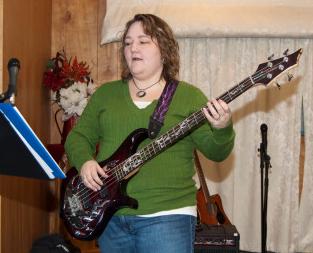 Churches merge to strengthen in Southern Oregon
Churches merge to strengthen in Southern Oregon
By Sheila Allen
NW Baptist Convention
Merging two congregations might raise eyebrows in some church planting circles, but not for some Northwest Baptists in Klamath Falls, Ore., an agricultural community 20 minutes from the California border.
Leaders at Baptist Church on Homedale, the newly named church that formed from the historic First Baptist Church and Suburban Heights Baptist Church, have baptized more people in the past three months than both baptized the prior year.
“We decided to get proactive,” said Paul Tiffee, pastor of the former First Baptist Church. “I developed a relationship with Bill Swartz after moving to Klamath Falls in 2004 and we began traveling to the Northwest Baptist Convention annual meeting together. In 2008 I first brought up the idea of joining forces.”
Swartz, pastor of the former Suburban Heights, initially was reluctant. Difficult issues between some in the two churches in years past caused Swartz some concern. But in 2010, as the two traveled once again, Swartz mentioned the possibility of opening a dialogue about a combined future. Instead of attending scheduled meetings, the pastors spent the time asking questions of trusted friends and leaders.
“After much prayer and reflection, Bill and I came to the conclusion this was where God was leading,” said Tiffee, who grew up in a pastor’s home in California. “We asked a few leaders from each church to meet and after hearing us out, all of them unanimously said they had felt God speaking to them.”
“God called me to this church in 1993 and I am thrilled to watch what he is continuing to do here,” said Swartz, a native of Kennewick, Wash. “Prior to the merger we had started to plateau and the congregation was beginning to age. We were a typical, comfortable, very traditional, financially stable church. Our people knew we had to do something, so we prayed asking the Lord for direction with a willingness to follow.”
The makeup of the two churches were different, with Suburban Heights attracting middle aged members, while First Baptist’s congregation included 25 percent second generation Hispanics, some senior adults, with the remainder under 50 years old.
“The things they have struggled with, we were strong in and vice versa,” Tiffee noted. “Bill and I complement each other very well. He has taken on the lead pastor and preaching role, while I am minister of education and administration to help fulfill the vision and mission. Suburban Heights had been seeking a music minister for over two years and we had a great worship band, so it was just a great fit.”
The churches wasted no time after the vote to merge in September. Within two weeks, the congregations had joined for services, put a new constitution and bylaws in place and reorganized to fit the new model. Both churches purposefully dissolved to form the new.
“Our people have great freedom,” Tiffee said. “We have three teams in place to help the church function including personnel, finance and planning. While we are learning as we go, it seems to be working well. A new evangelistic strategy that will include home groups is in the works.”
Each of the churches lost a few members that were not in favor of the new expression.
“We talked to leadership at the convention in advance and they were so willing to give us advice and encouragement,” Tiffee said. “It was incredible support from them, but it was a terrible time when we lost folks who were in leadership for decades.”
The new church has the older property previously owned by First Baptist for sale, but are open to other creative uses if a buyer doesn’t materialize.
“If God wants us to keep it, we will come up with some programs,” Swartz said. “There is a full size gym that can be used for basketball teams and other needs. God has been so good to us because neither church owed money on their facilities.”
Meanwhile, the congregation is forming a new identity as one unit.
“It is so fun to watch our members and their members make the mental switch to come here,” Swartz said. “The first Sunday people deliberately moved to sit somewhere else. Our biggest issue is parking capacity and our Sunday school rooms are out of space.”
The church currently offers one Sunday school hour and two worship services, each with a different music style.
“We still get blindsided from time to time because Satan is not a happy man right now,” Swartz said. “We have felt spiritual warfare but we are pushing ahead, because it would be easy to get comfortable again. We hope to eventually build another multi-purpose building. This is an area with high unemployment and one out of six people gets state or federal aid. We need to minister on that level and focus on how to get to the unlovely.
“If it wasn’t for a lot of prayer and following God from both sides, this would not have happened,” Swartz said. “If we are not willing to step out in faith, what are we here for?”
Disclaimer: Articles featured on Oregon Report are the creation, responsibility and opinion of the authoring individual or organization which is featured at the top of every article.


